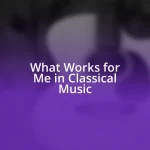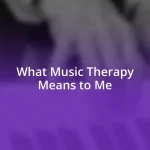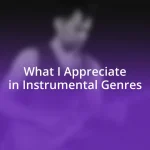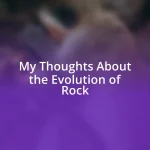Key takeaways:
- Teaching music significantly enhances cognitive development, boosts self-esteem, and fosters a sense of community among students.
- Understanding individual student needs through diverse teaching methods (visual, auditory, kinesthetic) and emotional support is crucial for effective learning.
- Continuous growth as an educator involves adaptability, collaboration with peers, and reflective practices to enhance teaching strategies and engage students meaningfully.

Key Benefits of Teaching Music
One key benefit of teaching music is the profound impact it has on cognitive development. I’ve often noticed, while guiding my students through complex pieces, how their ability to concentrate and think critically expands. Isn’t it fascinating how rhythm and melody can quite literally rewire our brains?
Another advantage I’ve seen is the boost in self-esteem that comes from mastering an instrument. I recall a shy student who, after weeks of diligent practice, performed in front of her classmates for the first time. The pride beaming from her face was a beautiful reminder of how music can empower individuals—don’t you think each victory, no matter how small, deserves to be celebrated?
Finally, teaching music fosters a deep sense of community. I’ve experienced countless moments where students bond over shared interests, collaborating on projects or simply jamming together. Isn’t that sense of belonging what we all crave? There’s something magical about creating and sharing music that unites people, forming connections that go beyond the notes on a page.

Understanding Student Needs
Understanding the unique needs of each student has been an enlightening journey for me. I once had a student who struggled with traditional reading methods in music, but when I introduced him to visual aids and hands-on activities, everything changed. Seeing his confidence soar as he became more engaged was a powerful reminder that each learner has their own path.
Recognizing that some students are auditory learners while others prefer kinesthetic approaches has helped me tailor my teaching methods effectively. For instance, I enjoyed experimenting with movement by incorporating dancing to rhythm exercises. Watching students connect with music in their way always fills me with joy. How do you think different teaching methods could impact a student’s engagement?
Additionally, I often find that emotional support plays a crucial role in my students’ learning experiences. One particular student, dealing with anxiety, struggled to participate in group activities. By fostering a supportive environment, she gradually opened up, leading to heartfelt performances. I believe that when we address the emotional side of learning, we can truly uplift and inspire our students.
| Student Need | Teaching Approach |
|---|---|
| Visual Learners | Using visual aids and hands-on activities |
| Auditory Learners | Incorporating music and sound exercises |
| Kinesthetic Learners | Including movement and rhythm activities |
| Emotionally Supportive | Creating a nurturing classroom environment |
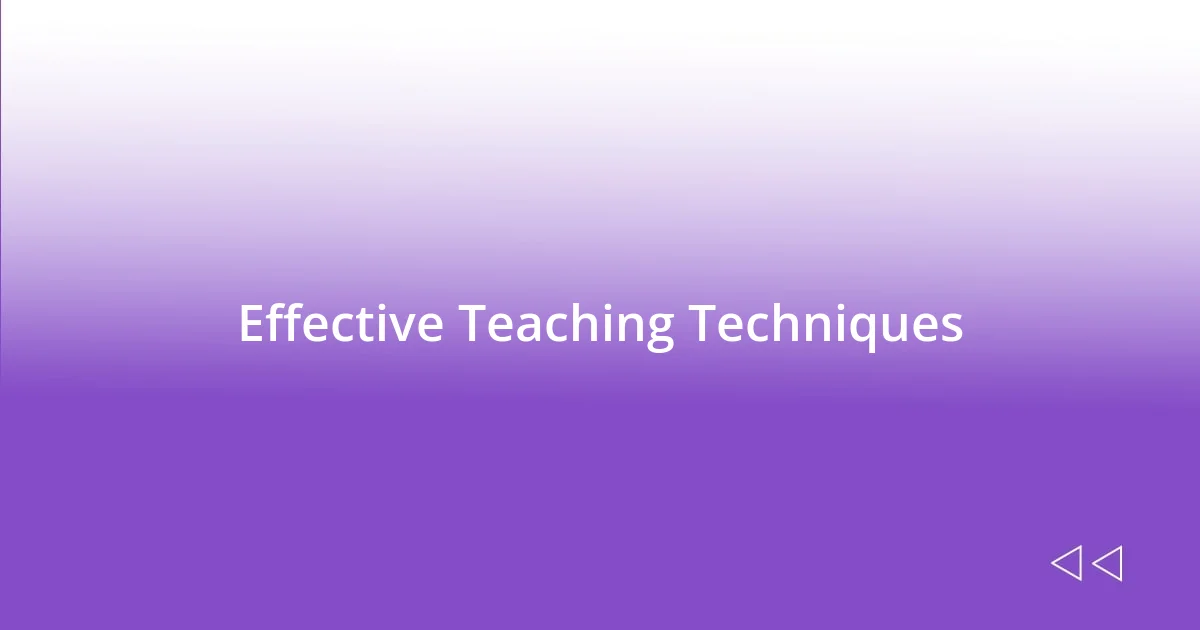
Effective Teaching Techniques
Teaching music to my students has truly refined my toolkit of effective teaching techniques. One method that has resonated deeply with me is the use of storytelling to convey musical concepts. I remember introducing the history behind a piece, and how it ignited a spark in my students’ minds. They began to relate the emotions within the music to real-life experiences, allowing them to express more passion in their performances. It’s always remarkable to witness the transformation of a lesson into a conversation that fuels creativity.
Here are some techniques I’ve found particularly effective:
- Storytelling: Contextualizing music through narratives enhances emotional connection.
- Hands-on Learning: Utilizing instruments during lessons to encourage exploration and self-discovery.
- Group Collaboration: Creating ensemble sessions where students guide each other fosters teamwork and interpersonal skills.
- Positive Reinforcement: Celebrating small milestones boosts confidence and motivation.
- Varied Instruction Methods: Adapting lessons for different learning styles ensures everyone can engage meaningfully.
In my experience, these strategies not only deepen understanding but also cultivate an enriching atmosphere where music becomes a shared journey. Seeing students come together to support one another in their learning reinforces the idea that music is as much about collaboration as it is about individual talent.

Building a Positive Environment
Creating a positive environment is essential to fostering a love for music in my students. I remember one particular lesson where the classroom atmosphere felt heavy. The minute I noticed my students’ hesitance, I decided to infuse humor into our warm-up exercises. The laughter that erupted not only lightened the mood but also encouraged everyone to engage. I believe that a sprinkle of joy can transform the energy in a room.
Moreover, establishing trust within the classroom has made all the difference. I once shared a personal story about my own struggles with a specific piece of music. To my surprise, many students opened up about their challenges too. This vulnerability created a sense of community, reminding everyone that it’s okay to stumble along the way. Have you ever felt more motivated to participate after someone else shared their struggle?
Lastly, I emphasize positive reinforcement in every lesson. When a student nails a difficult rhythm or takes a brave step to sing solo, I make it a point to celebrate that achievement, no matter how small. I often find that these moments of recognition not only boost individual confidence but also inspire peers to support one another. It’s gratifying to witness students applauding each other’s efforts—there’s something profoundly uplifting about being part of a team that cultivates growth and encouragement.

Encouraging Creativity in Students
Encouraging creativity in students is one of the most rewarding aspects of teaching music. I vividly recall a time when I introduced an improvisation exercise in class. At first, there was hesitation; students were nervous about stepping outside their comfort zones. But as I joined in, allowing my own mistakes to be a part of the creative process, the floodgates opened. Suddenly, they were daring to experiment with unexpected sounds, and the joy in their faces was priceless. Isn’t it amazing what can happen when we give permission to be imperfect?
I’ve also found that providing a platform for self-expression can be transformative. During one lesson, I encouraged my students to compose a short piece that reflected a significant experience in their lives. The stories they shared after their performances were incredible—everything from overcoming personal fears to celebrating happy moments. What struck me most was realizing how deeply personal music can be. Could any medium better communicate our innermost thoughts?
Creating an environment where students can share their creative endeavors has become paramount. I often arrange informal “show and tell” sessions, where students play their favorite pieces or showcase original compositions. Not only does this cultivate courage, but it sparks collaborative discussions, leading to constructive feedback among peers. Seeing them brainstorm together, excitedly bouncing ideas off one another, reinforces my belief: creativity thrives in an open and supportive atmosphere. After all, isn’t it uplifting to witness the magic that happens when young minds come together?

Navigating Challenges in Music Teaching
Navigating the myriad challenges in music teaching has taught me the importance of adaptability. I once encountered a group of students who seemed entirely disengaged during a complex theory lesson. Instead of pressing on, I pivoted and turned the material into a game involving rhythm and movement. Seeing their initial reluctance dissolve into laughter and excitement reminded me how quickly energy can shift with a little creativity.
Another significant challenge is meeting diverse learning needs in one classroom. I have students ranging from those who pick up concepts instantly to others who need more time and different approaches. I remember tailoring an exercise for a student who struggled with note recognition. I used colors and visual aids to help them connect with the notes, and watching their eyes light up with understanding was a powerful experience. Isn’t it fascinating how one small adjustment can open the door to learning for someone?
Lastly, patience has been my greatest ally in addressing the hurdles that arise in lessons. During a solo rehearsal, one of my students repeatedly stumbled over a tricky passage. Instead of expressing frustration, I shared my own struggles with performance anxiety from years ago. That moment of connection not only eased their tension but also reinforced a fundamental lesson: progress takes time, and it’s vital to be kind to ourselves along the journey. How often do we forget that every musician has faced challenges?

Continuous Growth as an Educator
Reflecting on my journey as a music educator, I’ve come to realize that continuous growth is absolutely essential. I still remember the first time I attended a workshop on integrating technology into music lessons. Initially, I was skeptical—how could an app enhance the artistry I was so passionate about? But as I explored various tools, my teaching transformed. I found myself excitedly incorporating digital composition programs that not only captivated my students but also encouraged creativity in ways I hadn’t imagined. Isn’t it fascinating how stepping outside our comfort zones can lead to breakthroughs in our practice?
Moreover, I’ve learned that collaborating with fellow educators can be incredibly enriching. A couple of years ago, I joined a professional learning community focused on music education. The discussions we had—sharing strategies, experiences, and even failures—were illuminating. It dawned on me that everyone has valuable insights, regardless of their experience. Engaging with others provides fresh perspectives that breathe new life into my teaching. Don’t you think that whether in music or any other discipline, collaboration is where real growth happens?
In my view, reflection is a cornerstone of effective teaching. After each semester, I take time to evaluate what worked and what didn’t. I can’t forget a particular instance where a project on world music fell flat because students felt disconnected from the material. This experience pushed me to dig deeper into cultural contexts and encourage my students to bring their own backgrounds into our discussions. I often wonder—how can we create authentic learning experiences that resonate? My ongoing journey of reflection ensures I’m constantly evolving, striving to meet the needs of my students while staying true to the art form I love so dearly.

